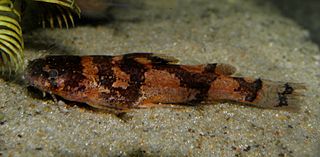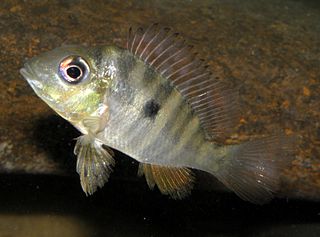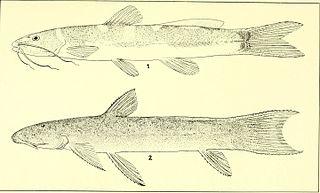
Hyphessobrycon is a genus of freshwater fish in the family Characidae. These species are among the fishes known as tetras. The genus is distributed in the Neotropical realm from southern Mexico to Río de la Plata in Argentina. Many of these species are native to South America; about six species are from Central America and a single species, H. compressus is from southern Mexico.

Astyanax is a genus of freshwater fish in the family Characidae of the order Characiformes. Some of these fish, like many of their relatives, are kept as aquarium pets and known collectively as tetras. With around 150 described species and new ones being described yearly, this genus is among the largest of the entire order; Hyphessobrycon also has more than 145 species and which one is larger at any one time depends on whether more species have been recently described in one or the other. The blind and colorless cave tetra of Mexico is a famous member of the genus, but its taxonomic position is disputed: Some recognize it as part of the Mexican tetra and this is supported by phylogenetic evidence, but others recognize the cave form as a separate species, A. jordani.

Crenicichla is a genus of cichlids native to South America commonly known as the pike cichlids. They are found in most tropical and subtropical freshwater habitats between the Andes and the Atlantic.

Microglanis is a genus of fish in the family Pseudopimelodidae native to South America. This genus has the widest distribution within its family, with species ranging from the Guianas to Venezuela; western slope of the Andes in Ecuador and Peru to the Río de La Plata basin in Argentina. They occur eastward to the Orinoco and Amazon basins. It is also present in the eastern coastal rivers of Brazil.

Gymnogeophagus is a genus of cichlid fishes from South America, where they are known from various river basins in southern Brazil, Paraguay, Uruguay and northern Argentina. They are part of a group popularly known as eartheaters.

Pimelodus is a genus of fish in the family Pimelodidae native to Central and South America.

Moenkhausia is a genus of freshwater fish in the family Characidae native to tropical and subtropical South America. These are medium-sized tetras where the largest species only reach around 12 cm (4.7 in).

Odontesthes is a genus of Neotropical silversides. They are found in fresh, brackish and salt water habitats in the southern half of South America, as well as the offshore Juan Fernández and Falkland Islands. Additionally, O. bonariensis has been introduced to other continents.

Bryconamericus is a genus of characins found in Central and South America.

Deuterodon is a genus of characins from river basins in southern and southeastern Brazil, with a single species of uncertain taxonomic status, D. potaroensis, from Guyana. These are small fish that reach up to 12.6 cm (5.0 in) in total length. They are omnivores with a specialized mouth structure that allows them to scrape algae and debris off bedrock.

Hemibrycon is a genus of characins. They are mainly found in South America, Trinidad in the Caribbean), and H. dariensis of east Panama.

Hemigrammus is a genus of freshwater fish in the family Characidae native to South America and commonly seen in the aquarium trade. These are medium-small tetras where the largest species reach up to around 11 cm (4.3 in).

Jupiaba is a genus of characins from South America. with 27 currently described species:
Knodus is a genus of characins, small freshwater fish from South America.
Odontostilbe is a genus of characins from tropical Central and South America, with 17 currently recognized species:
Serrapinnus is a genus of characins from tropical South America.
Spintherobolus is a genus of characins that are endemic to river basins in southern and southeastern Brazil from Santa Catarina to Rio de Janeiro. All four species in the genus are considered threatened by Brazil's Ministry of the Environment. They are small fish, up to 6.1 cm (2.4 in) in standard length.

Rhamdella is a genus of three-barbeled catfishes native to South America.

Anablepsoides is a genus of killifish in the family Rivulidae native to tropical South America and the Lesser Antilles. The majority are from the Amazon and Orinoco basins, as well as freshwater systems in the Guiana Shield, but a few species are from northern Venezuela, northeastern Brazil and the Lesser Antilles. Although largely restricted to lowlands, a few species occur in the lower East Andean foothills. They are mostly found in shallow fresh water swamps, streams, edges of rivers, ponds and pools, but a few may occur in brackish estuaries. They are able to jump over land and breathe air for short periods, allowing them to access isolated waters inhabited by few or no other fish. Several Anablepsoides species have small distributions and some are seriously threatened by habitat loss; the entire known range of A. xinguensis is in the area flooded by the Belo Monte Dam.

The tailspot tetra is a freshwater fish that lives in the coastal river regions of upper South America. Both its common and scientific names reference the distinct spot of color present on the tail fin, which is one of its defining characteristics. It is a small fish, reaching 4.8 in at its longest. Despite its small size, it is an active swimmer, with a preference for fast-flowing waters.
















